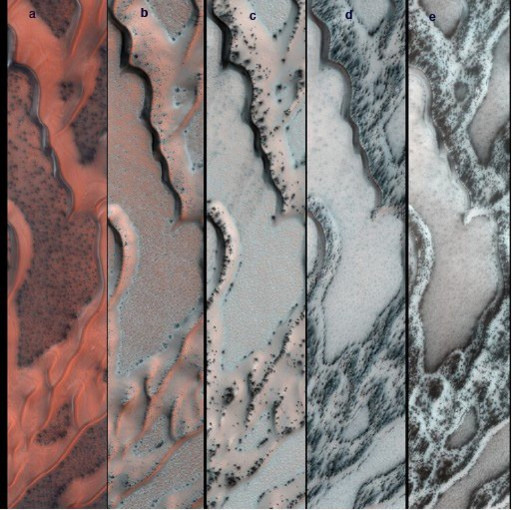On Mars, Dry Ice 'Smoke' Shows The Red Planet Is Still Alive And Changing [VIDEO]

NASA’s Mars Reconnaissance Orbiter, or MRO, spacecraft has produced an amazing series of photographs showing seasonal changes on Mars that include dry ice “smoke” carving grooves into the Red Planet’s sand dunes.
Associated MRO data, published in three new journal articles, show that even though many think of Mars as a largely dead planet, it is actually still undergoing a large degree of geological change, according to Space.com.
"It's an amazingly dynamic process," Candice Hansen, senior scientist at the Planetary Science Institute in Tucson, Ariz., and lead author of one of the studies, said in a statement hosted by NASA. "We had this old paradigm that all the action on Mars was billions of years ago. Thanks to the ability to monitor changes with the Mars Reconnaissance Orbiter, one of the new paradigms is that Mars has many active processes today."
So what exactly is cutting this series of grooves into Mars’ sand dunes?
In the Martian spring, hotter weather thaws a frozen layer of carbon dioxide -- better known as dry ice in this form -- on the planet's surface.
Contrary to expectations, however, it is the underside of the layer that thaws first, creating larger and larger pockets of dry ice “smoke” or gas underneath the surface. Eventually, the gas breaks free and creates the noticeable grooves throughout Mars’ dunes.
These observations, recently published in the planetary-science journal Icarus, were made over the course of three Martian years -- about six Earth years.
"It is a challenge to catch when and how those changes happen, they are so fast," Ganna Portyankina, a researcher at the University of Bern in Switzerland and lead author of another of the three studies, said in the statement hosted by NASA. "That's why only now we start to see the bigger picture that both hemispheres actually tell us similar stories."
Watch NASA's "Mars: Dry Ice & Dunes" video explaining the phenomenon below.
Embedded video from
NASA Jet Propulsion Laboratory California Institute of Technology
© Copyright IBTimes 2024. All rights reserved.





















